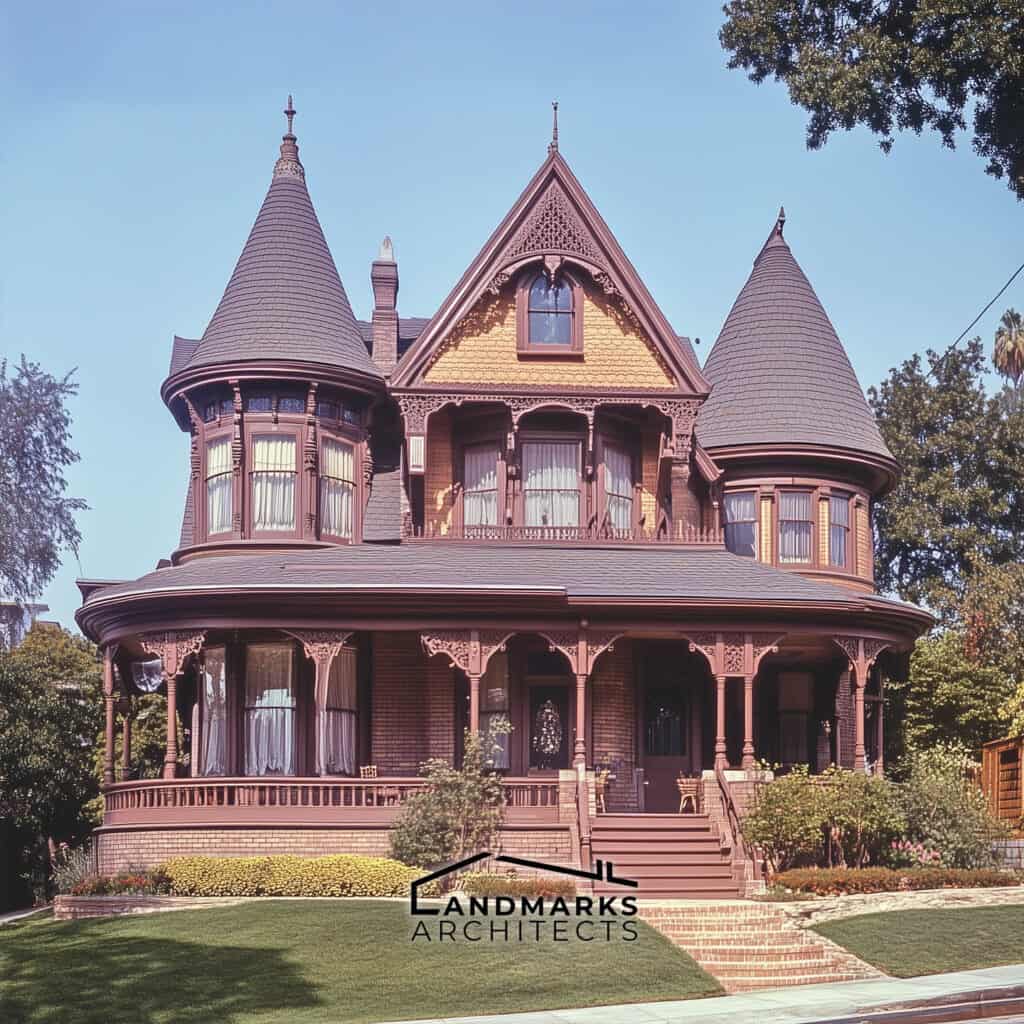
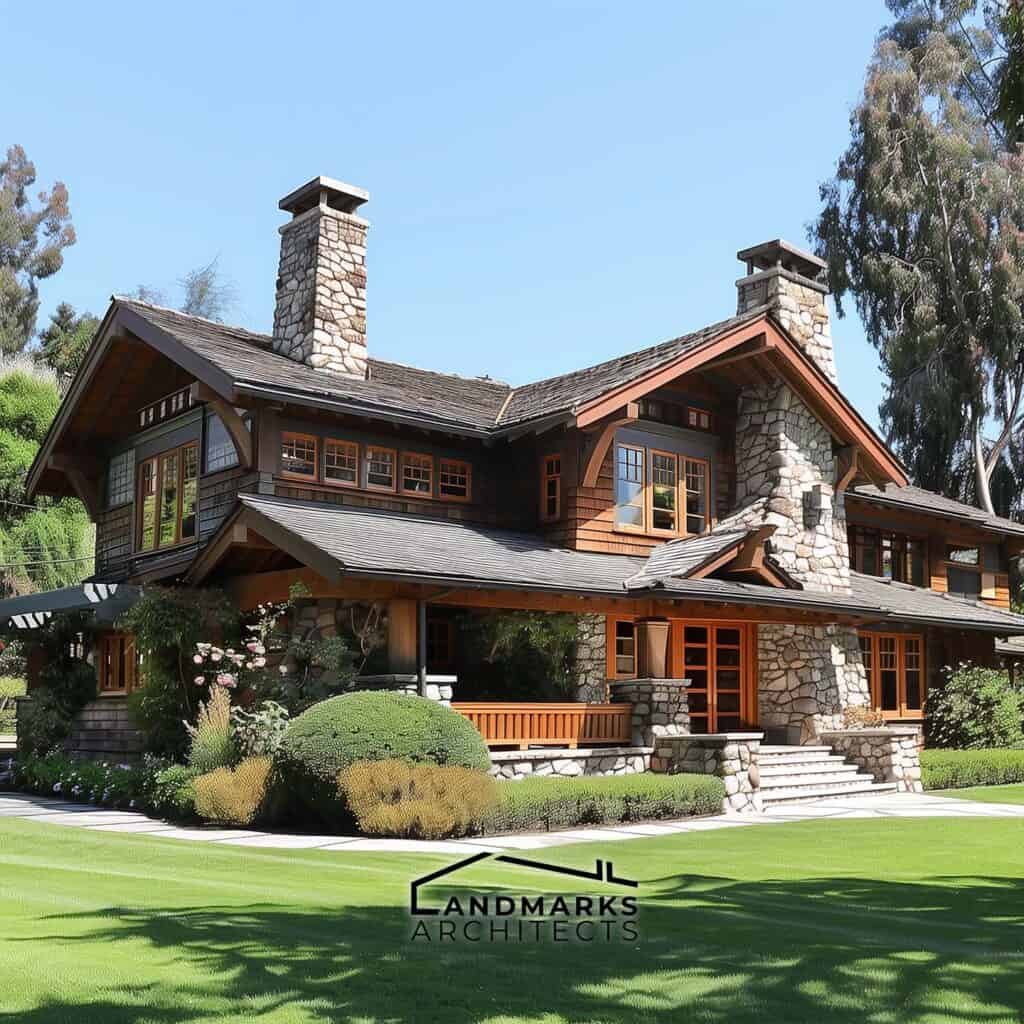
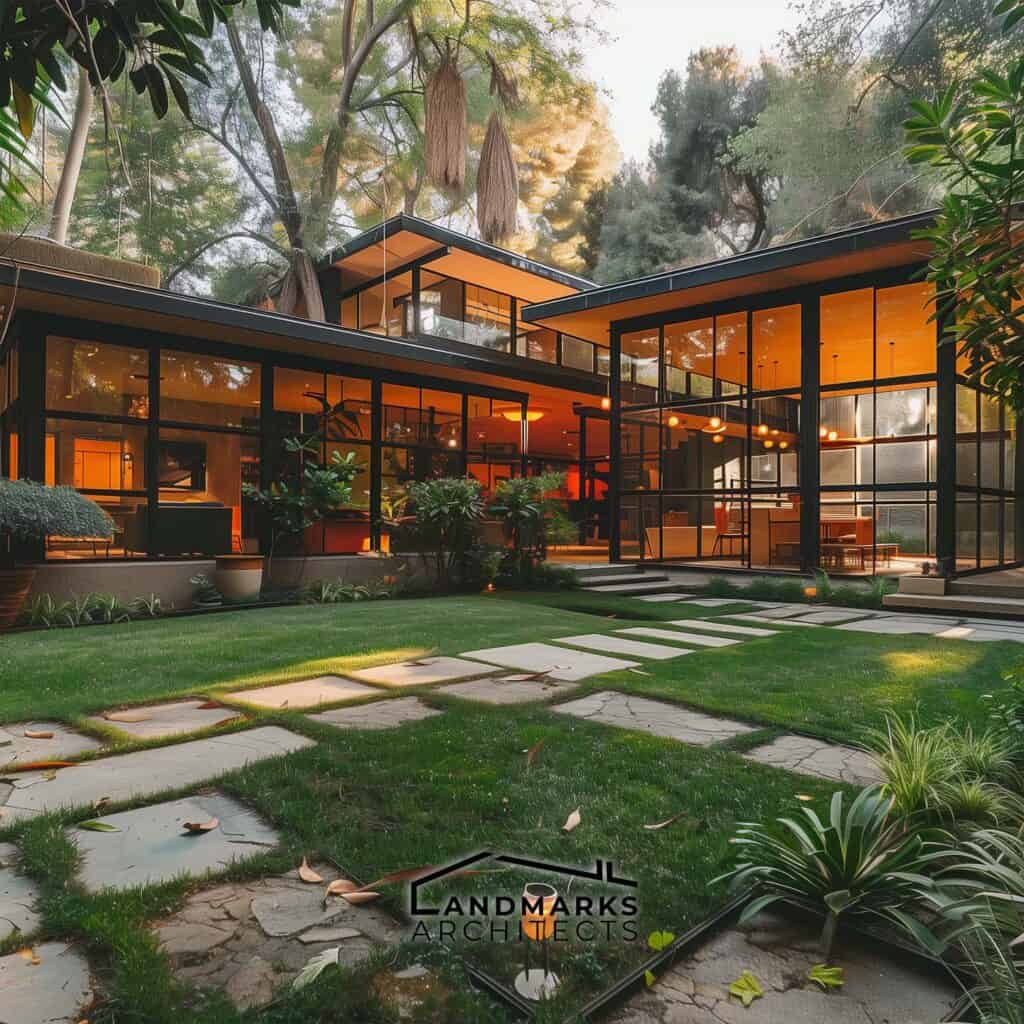
Curious about how Los Angeles’ architectural styles have shaped the city? From Victorian elegance to sleek Mid-Century Modernism, LA’s diverse styles tell a fascinating story.
As a homeowner or design enthusiast, you deserve to know how these iconic styles influence the cityscape. With so many styles to explore, you might wonder where to start.
Consider checking out the best cities for architecture in the USA for inspiration and insight into diverse architectural designs.
At Landmarks Architects, we make it easy to understand Los Angeles’ top 12 architectural styles. With our experience, we’ll walk you through:
- Victorian: Detailed, ornate designs from the 1800s.
- Arts and Crafts: Emphasis on quality craftsmanship and natural materials.
- Beaux-Arts and Mission Revival: Classic and historic charm.
- Spanish Colonial Revival and Mediterranean Revival: Warm, inviting early 20th-century looks.
- Art Deco and Streamline Moderne: Glamorous and sleek 1920s and 30s styles.
- Mid-Century Modern and Googie: Innovative designs from the post-war era.
- International Style and Modernist: Minimalist and functional mid-20th-century designs.
Ready to explore these iconic Los Angeles architectural styles? Keep reading to see how types of architectural styles have shaped the city and how they can inspire your design projects.
1. Victorian Style
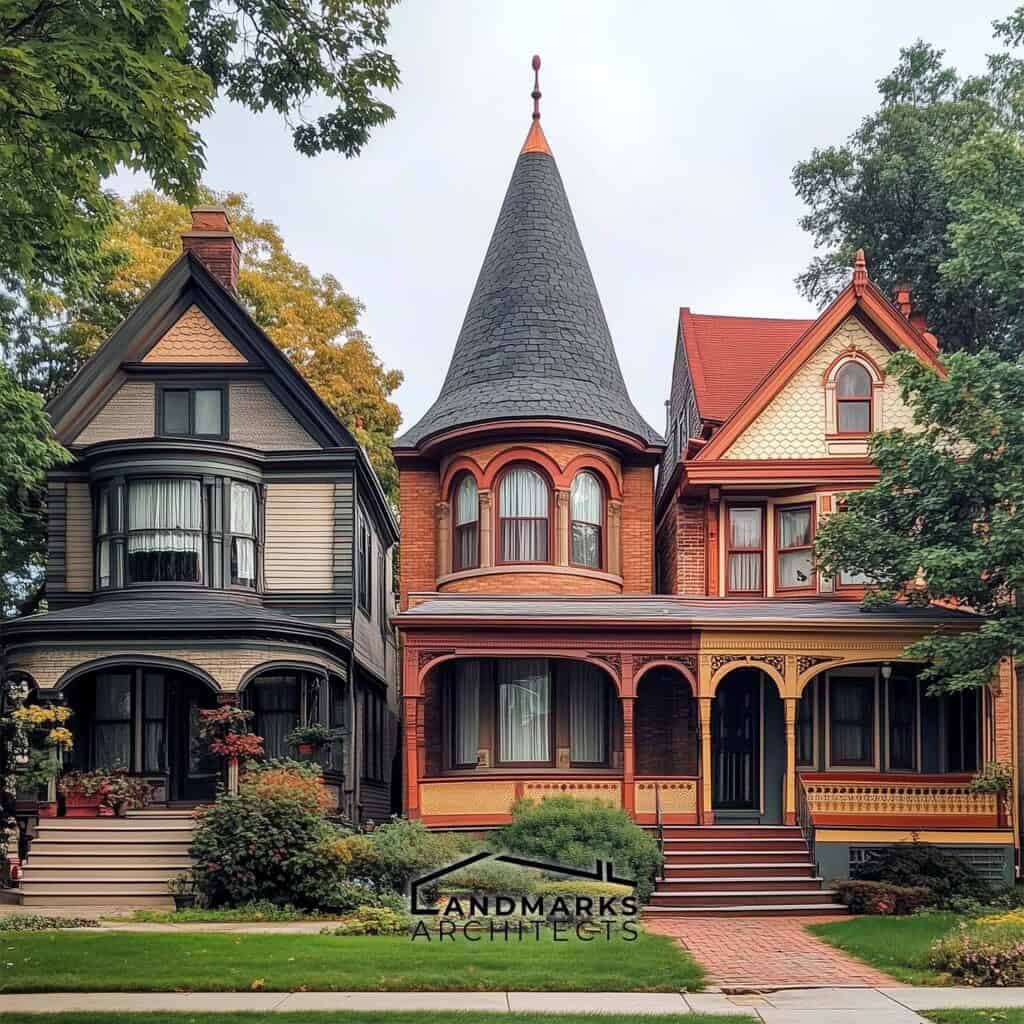
The Victorian era, from 1837 to 1901, brought several new architectural styles to the Los Angeles area. These styles included Queen Anne, Eastlake, and Folk Victorian, each featuring detailed and decorative designs.
As Los Angeles grew, Victorian architecture became more common, including elements of Modern Victorian architecture. You can still see its influence in neighborhoods like Angelino Heights and West Adams.
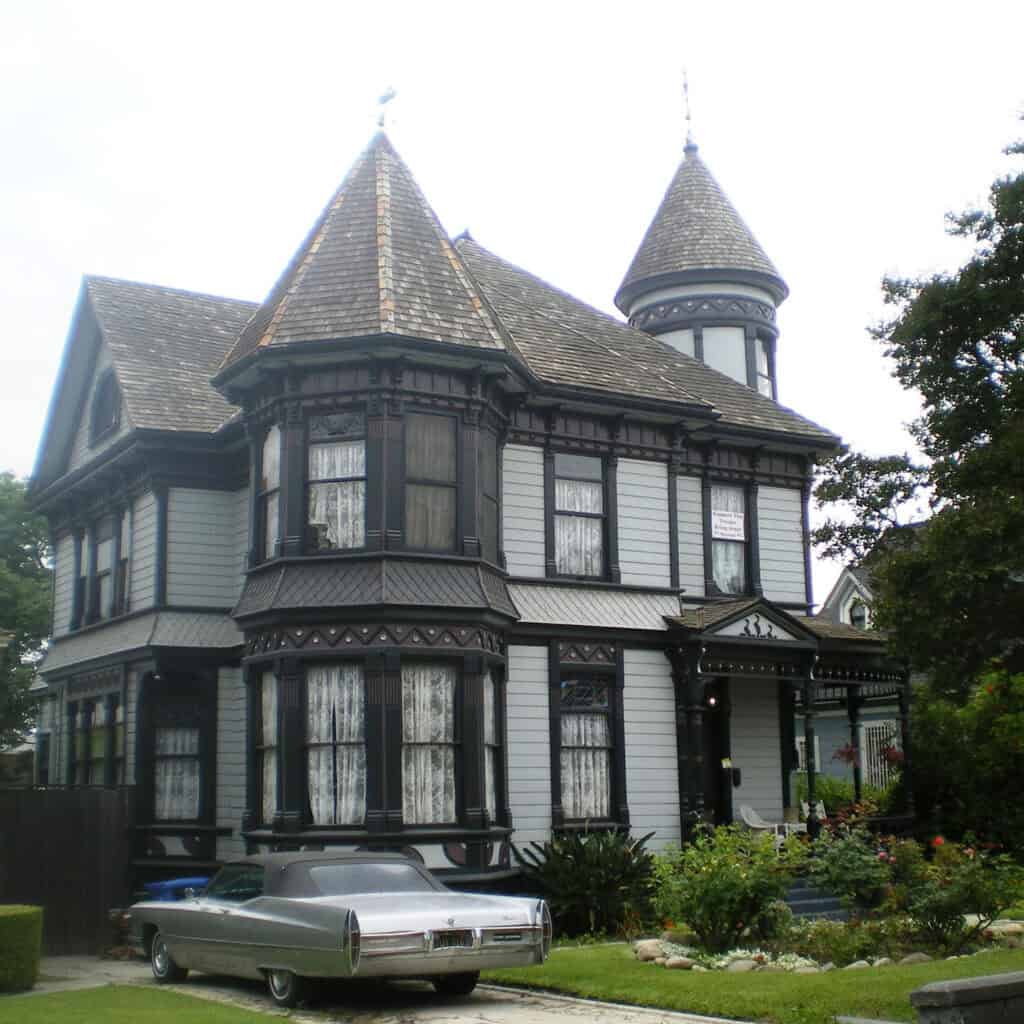
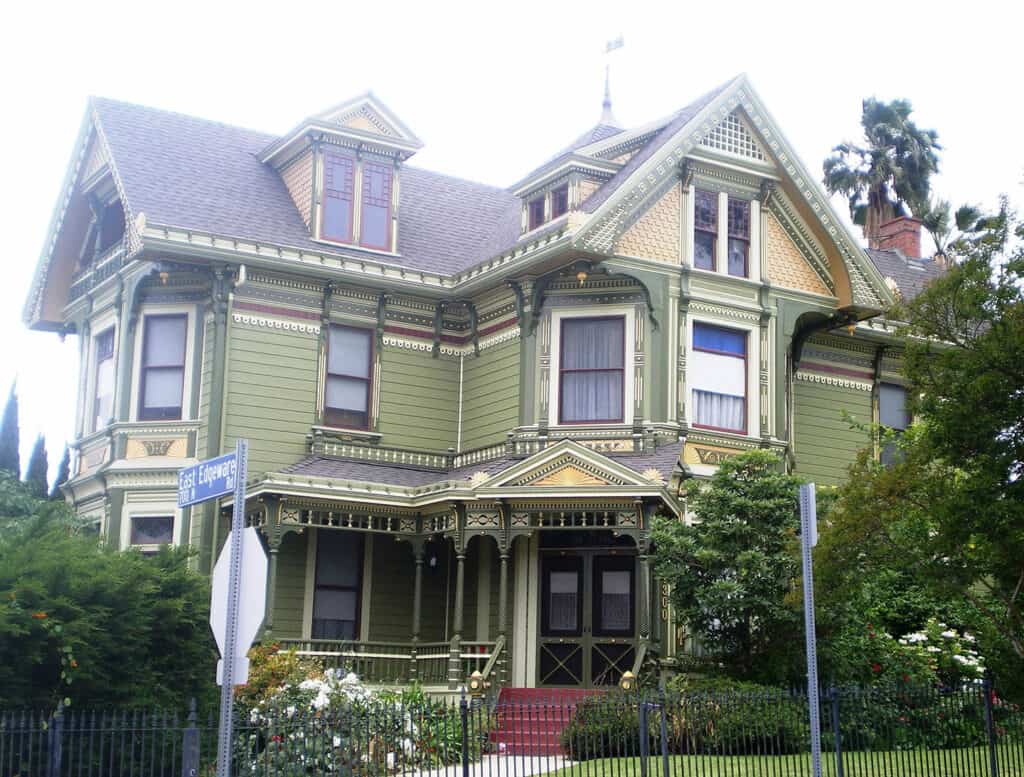
Queen Anne: Known for its asymmetrical shapes, towers, round or octagon-shaped rooms, fish-scale siding, and detailed brickwork.
Eastlake: Features steeply pitched roofs, rectangular windows, decorative brackets, and detailed woodwork with curved designs.
Folk Victorian: Simpler and more balanced, with gabled roofs and front porches decorated with ready-made trim.
One well-known place that shows off this style is the Carroll Avenue Historic District in Angelino Heights. Here, you can find beautifully kept Victorian homes, especially in the Queen Anne and Eastlake styles. This era is still an important part of Los Angeles’ diverse architectural history.
2. Arts and Crafts Movement
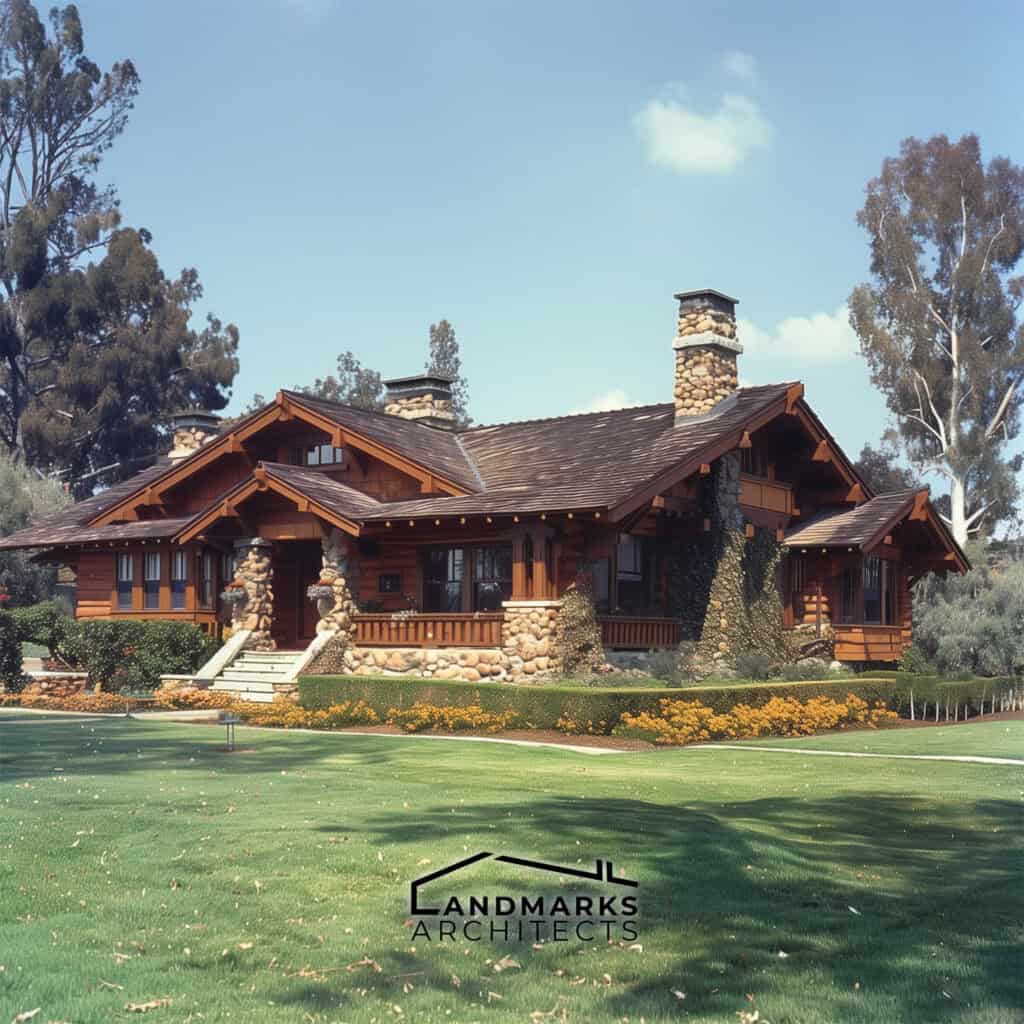
The Arts and Crafts movement began in late 19th-century England. It had a significant impact on Los Angeles architecture in the early 20th century. It highlighted skilled craftsmanship and the use of natural materials.
Characteristics:
- Craftsman Bungalows: Low-pitched rooflines, overhanging eaves, extensive woodwork, and decorative brackets.
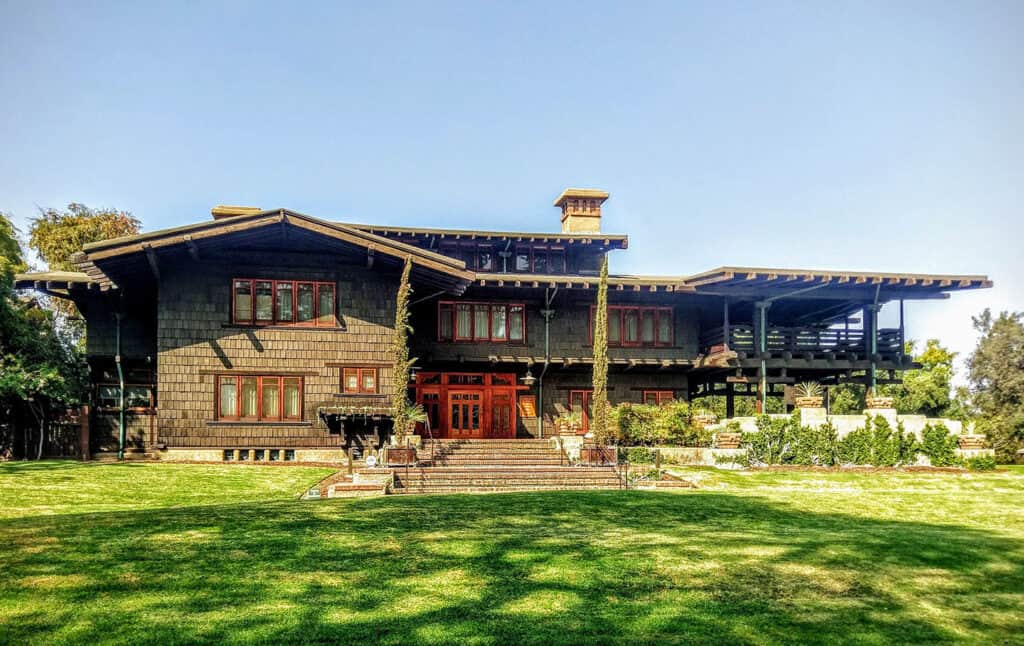
A notable example is The Gamble House, located in Pasadena. This Craftsman-style home features exceptional woodwork and distinctive low, sloping roofs. It shows the movement’s focus on natural materials and craft in L.A. architecture.
3. Beaux-Arts
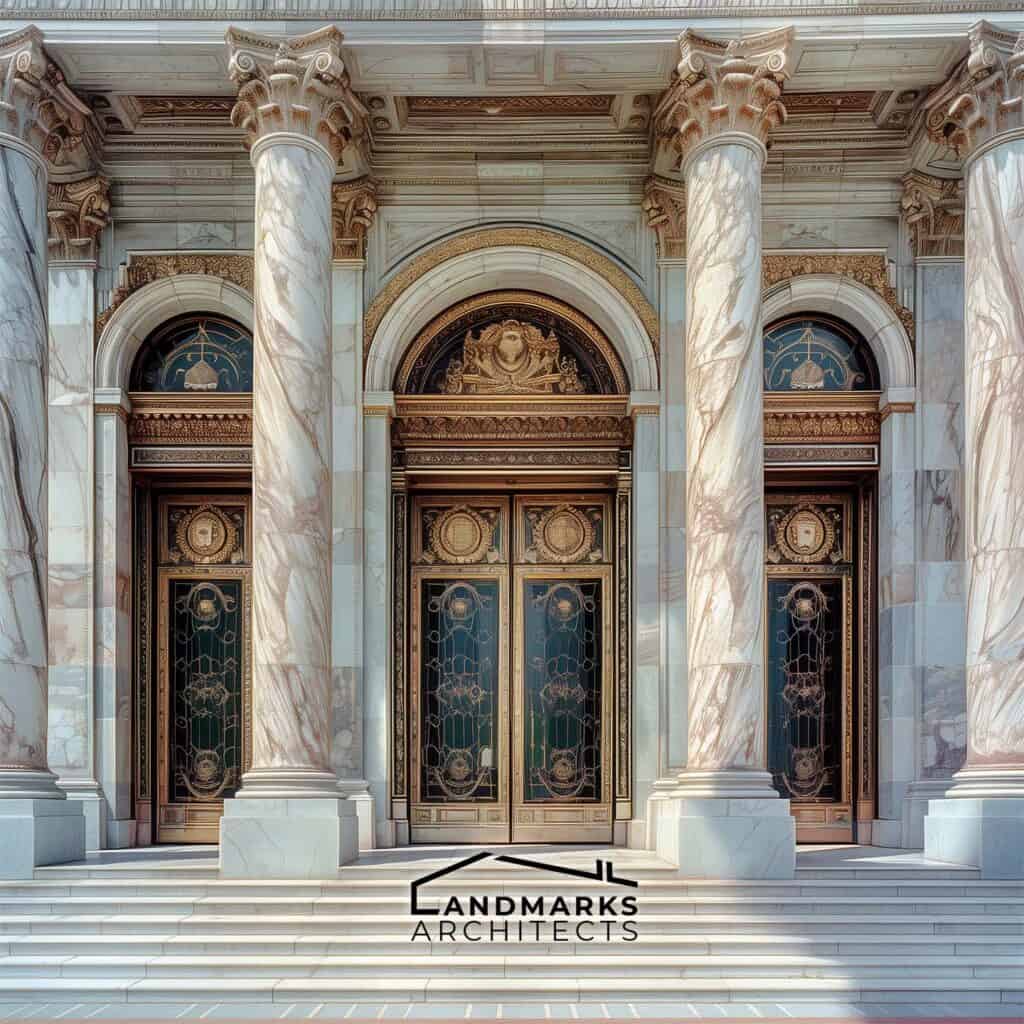
The Beaux-Arts style became popular in early 20th-century Los Angeles. It drew from classical European architecture. This style is known for its grandeur and symmetry. It embraced classical elements, like columns and arches, with ornate details.
It showed the city’s wish to boost its elegance and culture during a time of growth.
Characteristics:
- Classical elements: columns, arches, vaults, and domes.
- High-quality materials: marble, brass, and bronze.
- Decorative brickwork and intricate bas-relief sculptures.

A famous example is the Hall of Justice, nestled in downtown Los Angeles. This building is a testament to Beaux-Arts architecture. It blends grandeur with classical details.
See Also Famous Buildings in the USA: 12 Fascinating Landmarks From Different Eras
4. Mission Revival
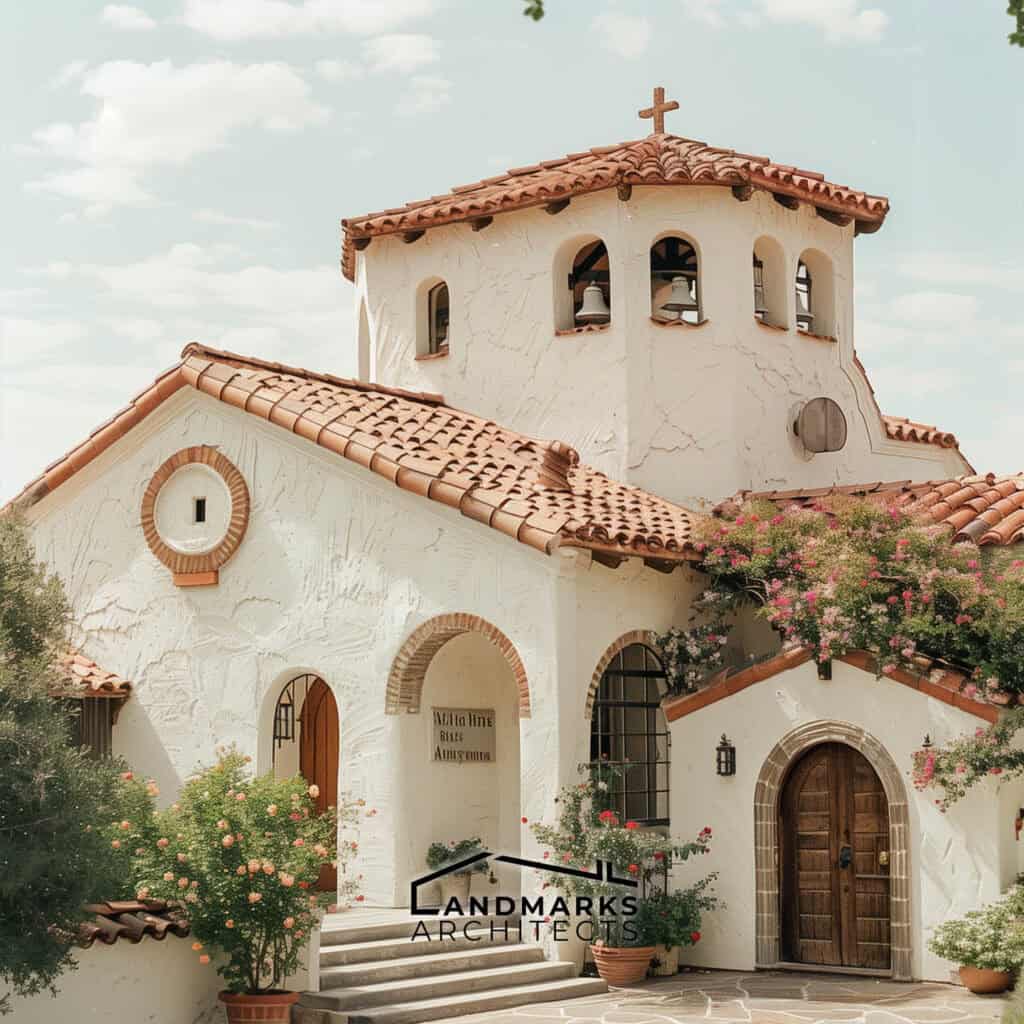
The Mission Revival style, from the late 19th and early 20th centuries, drew inspiration from California’s Spanish missions. This style became popular in Southern California. It suited the climate and had historical connections.
Characteristics:
- Low-pitched red clay roofs, plain stucco exteriors, and arched openings.
- Mission-style parapets and arched windows.
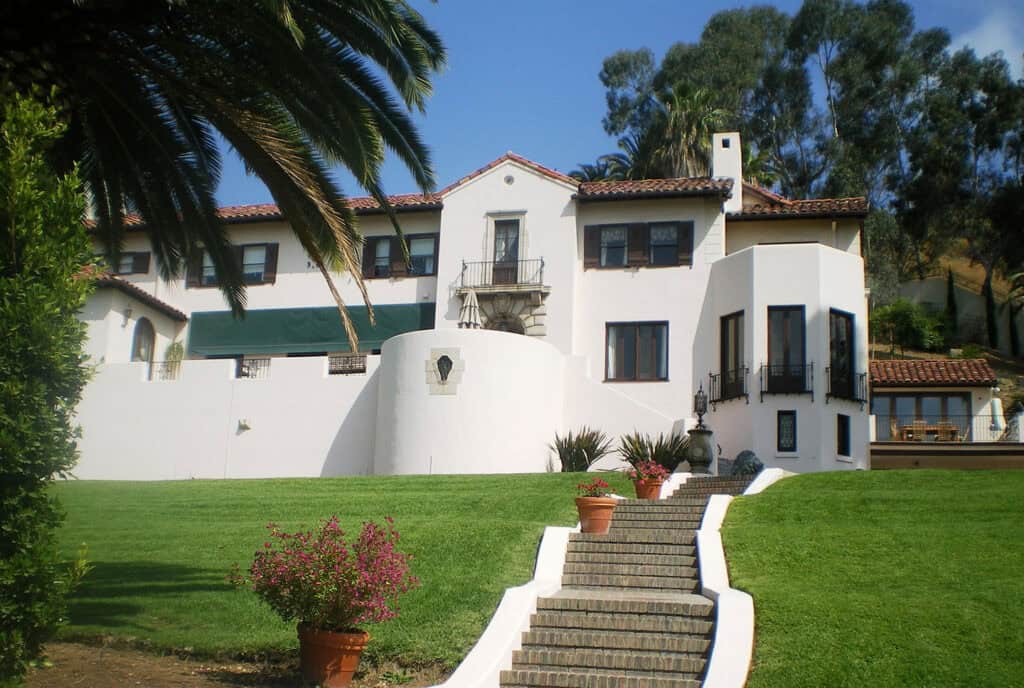
A notable example of the Mission Revival style in LA is the C.E. Toberman Estate in the Hollywood Hills. This property shows the style’s embrace of stucco, red tile roofs, and arched doorways. It demonstrates how upscale Los Angeles homes integrate architectural styles.
5. Spanish Colonial Revival
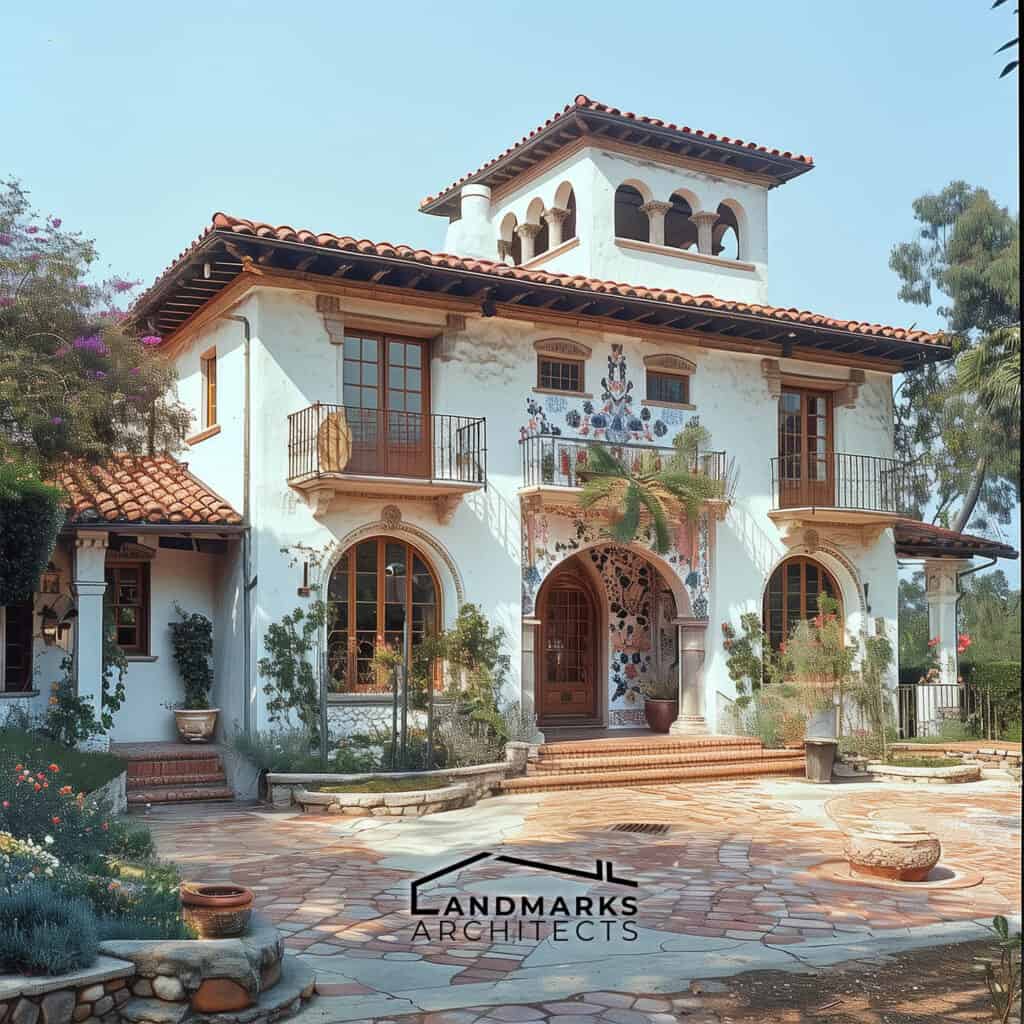
After the 1915-1917 Panama-California Exposition, a trend emerged in Los Angeles. It was the Spanish Colonial Revival style.
Characteristics:
- White stucco walls, red tile roofs, arched windows, and wrought-iron accents.
- Courtyards and painted tile details.
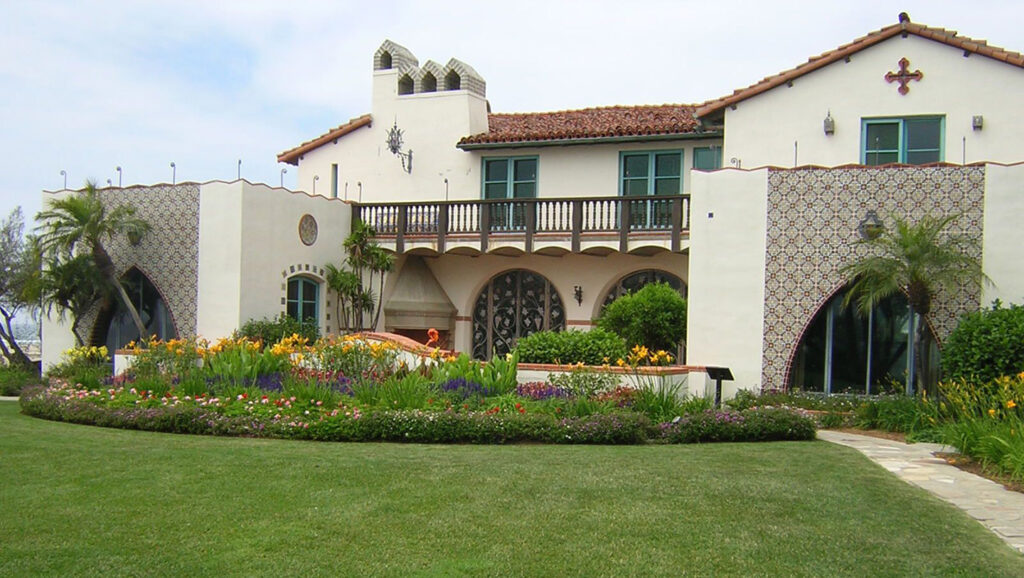
A notable example of the Spanish Colonial Revival style is The Adamson House in Malibu. Built-in 1929, it showcases the style’s classic features with its intricate tile work, white stucco exterior, and red-tile roof.
This historic home beautifully captures the elegance and charm of early 20th-century Los Angeles architecture.
6. Mediterranean Revival Style
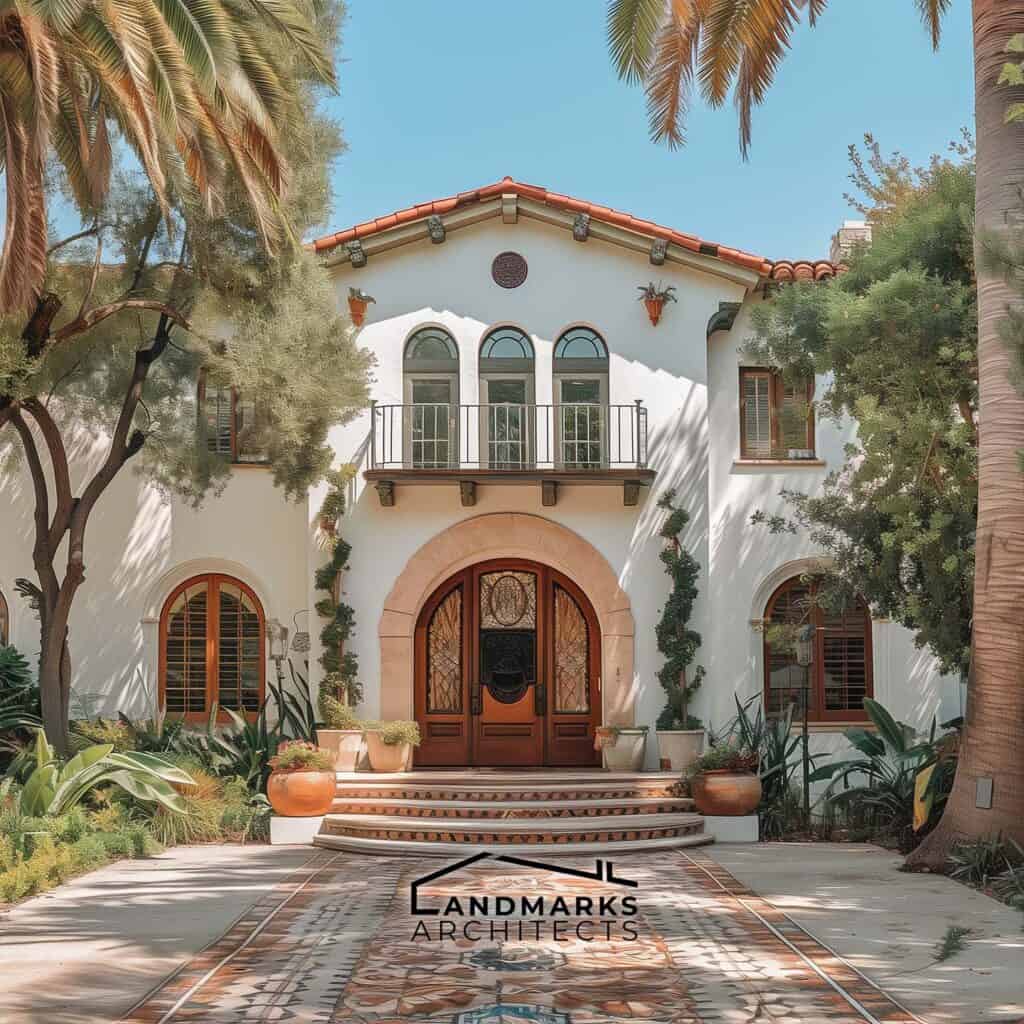
In the 1920s and 1930s, Los Angeles embraced the Mediterranean Revival style. It reflected the beauty of Mediterranean coastal architecture. Its design was ideal for the Southern California climate.
Characteristics:
- Stucco exteriors, red clay tile roofs, arched windows, and intricate ironwork.
- Courtyards and the use of natural materials, like wood and stone.

A notable example of the Mediterranean Revival style in Los Angeles architecture is Pasadena City Hall. Built in the 1920s, this landmark is a testament to its style. It has stucco exteriors, red clay tile roofs, and arched windows. They blend into the vibrant landscape around it.
See Also 1960s Style Architecture: 17 Key Insights from Historical Context to Iconic Projects
7. Art Deco
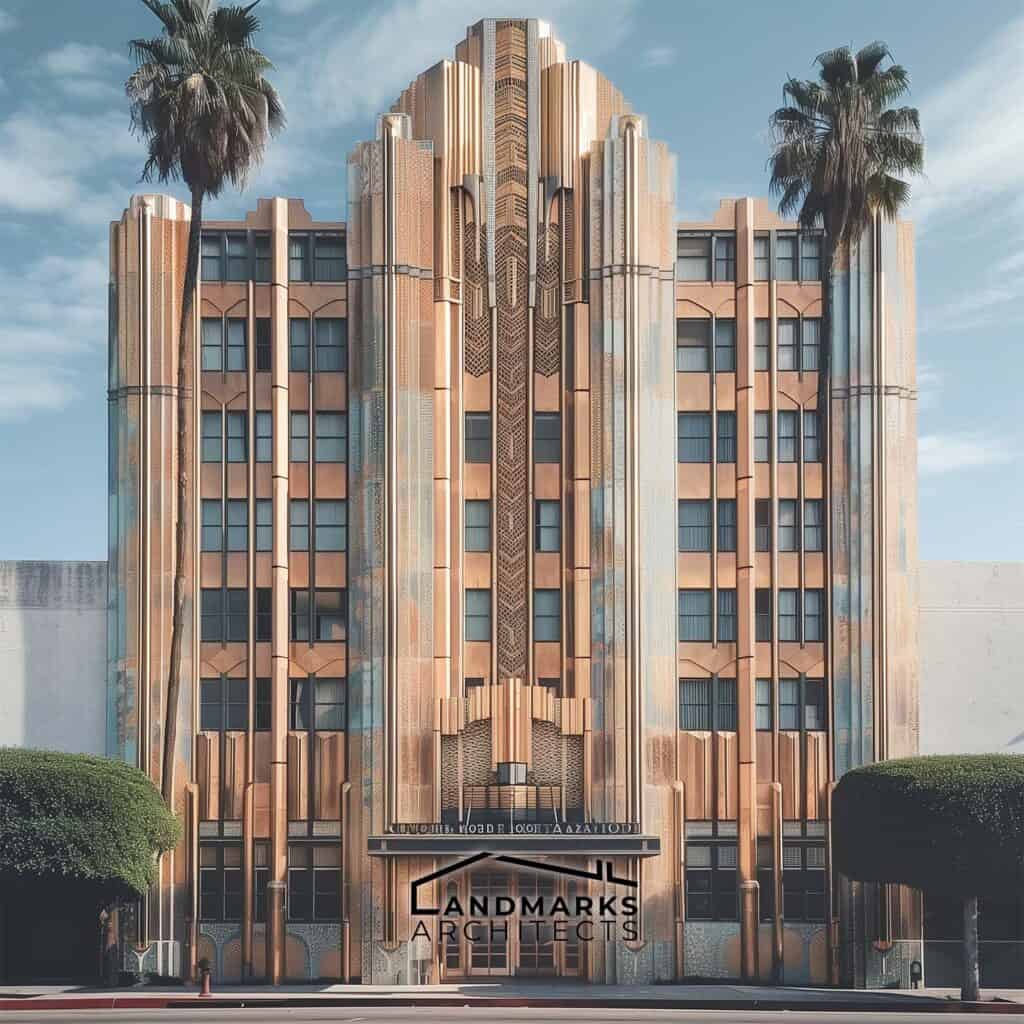
Art Deco emerged in Los Angeles in the 1920s and 1930s. It brought a glamorous, modern style to the city’s architecture. It was popular in commercial buildings and theaters. It showed the city’s growing links to the film industry. It also showed its embrace of bold, new design.
Characteristics:
- Geometric forms such as ziggurats and chevrons.
- Smooth finishes in stone or metal.
- Vibrant colors and intricate decorative patterns.
- Strong symmetry and bold lines.
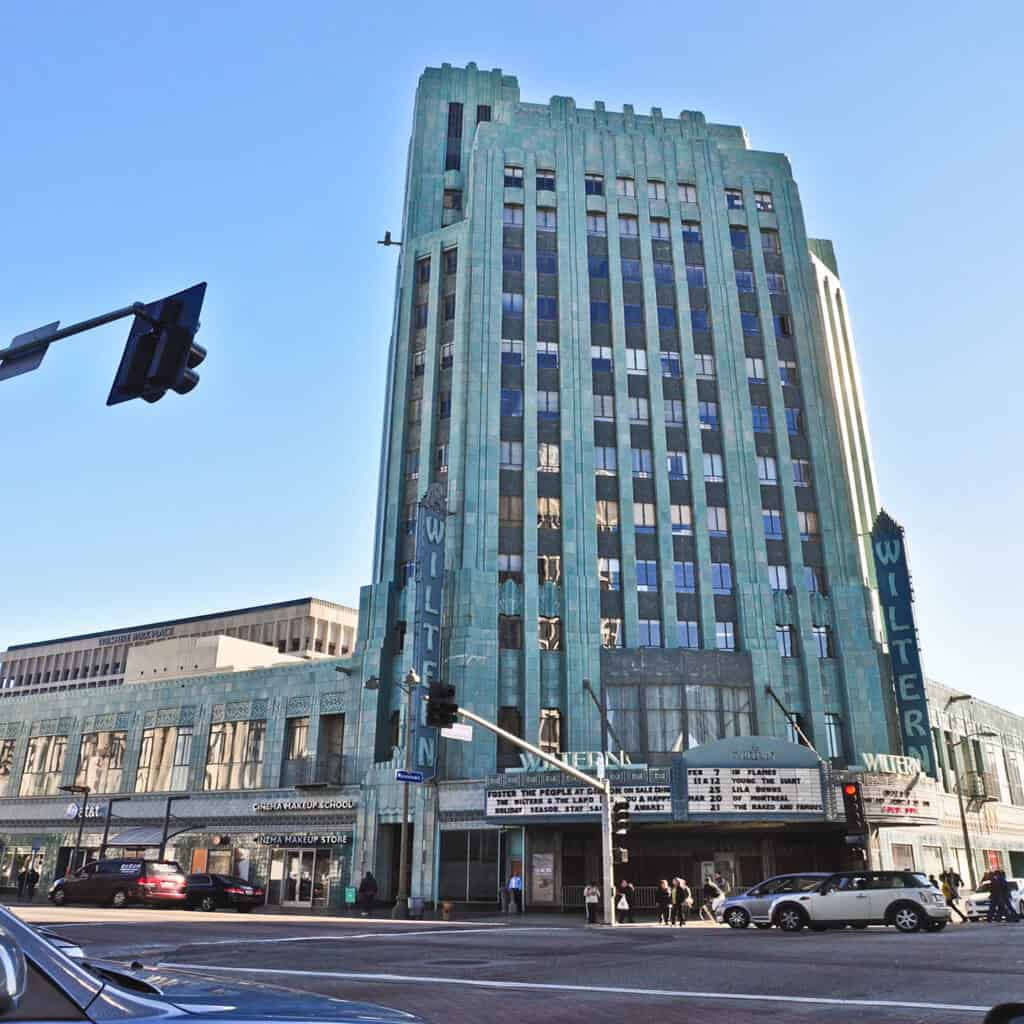
A key example of Art Deco architecture in LA is the Wiltern Theatre in Koreatown. This landmark embodies the style’s allure. Its vibrant colors and geometric details capture the essence of Art Deco design.
8. Streamline Moderne

Streamline Moderne emerged in the 1930s. It embodied sleek designs inspired by luxury trains, planes, and ocean liners. While it was part of the broader Art Deco movement, it focused more on smooth, aerodynamic forms.
Characteristics:
- Curved railings and porthole windows.
- Chrome accents and aerodynamic curves.
- Horizontal lines and smooth, sleek surfaces.
- Emphasis on speed and efficiency in design.
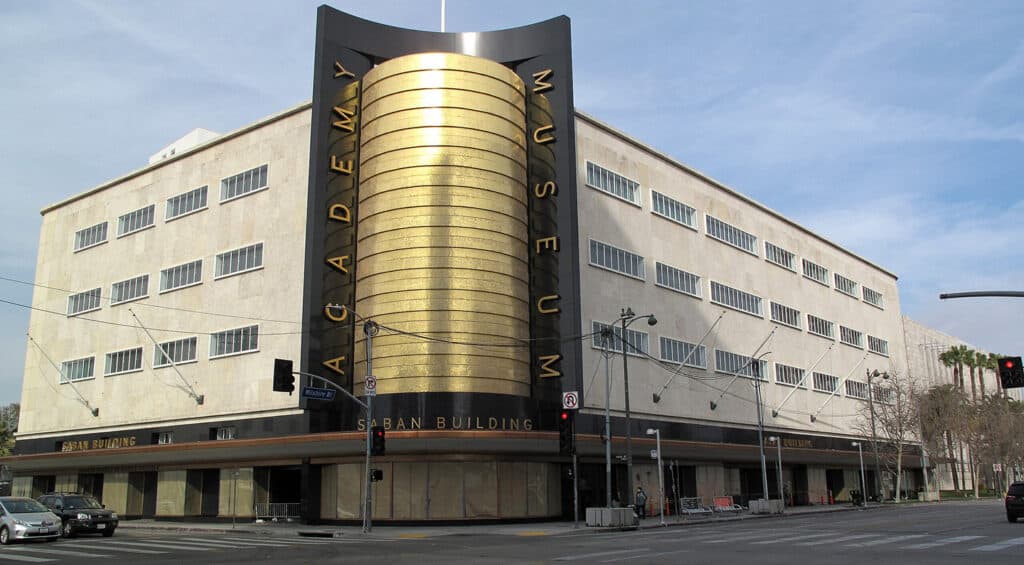
The Saban Building in Hollywood stands as a prime example of Streamline Moderne. Its design features smooth, curved lines and a golden cylindrical corner tower, reflecting the futuristic and efficient spirit of the 1930s.
Its sleek facade and streamlined features make it a notable landmark in LA’s architectural history.
9. Mid-Century Modern
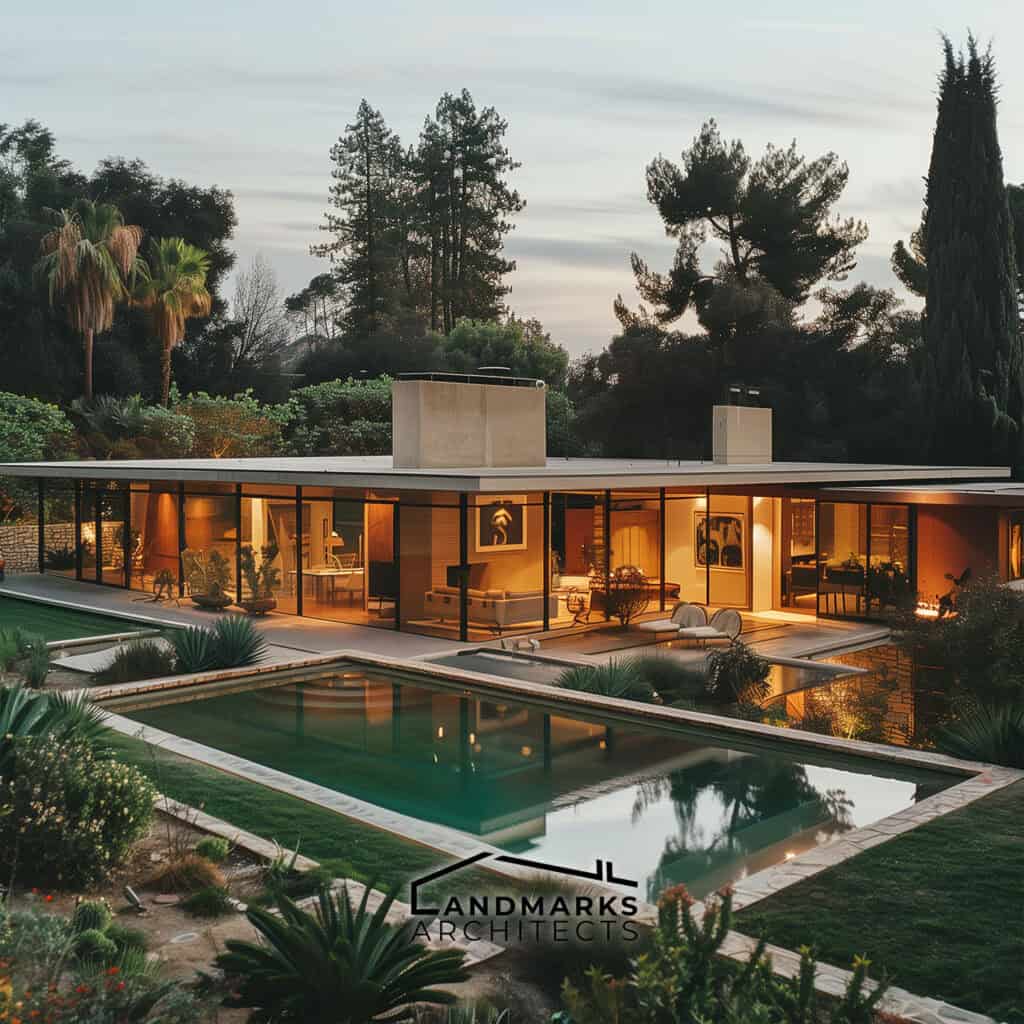
Mid-century architecture became prominent in Los Angeles after World War II, starting around the 1940s and continuing into the 1960s. This style emerged to address the housing shortage with innovative designs.
Mid-century architecture arose to meet a growing population. It emphasized open, functional spaces that connected with nature.
Characteristics:
- Flat or low-pitched roofs
- Large glass windows and open floor plans
- Minimalist design with clean lines.
- Focus on indoor-outdoor living.
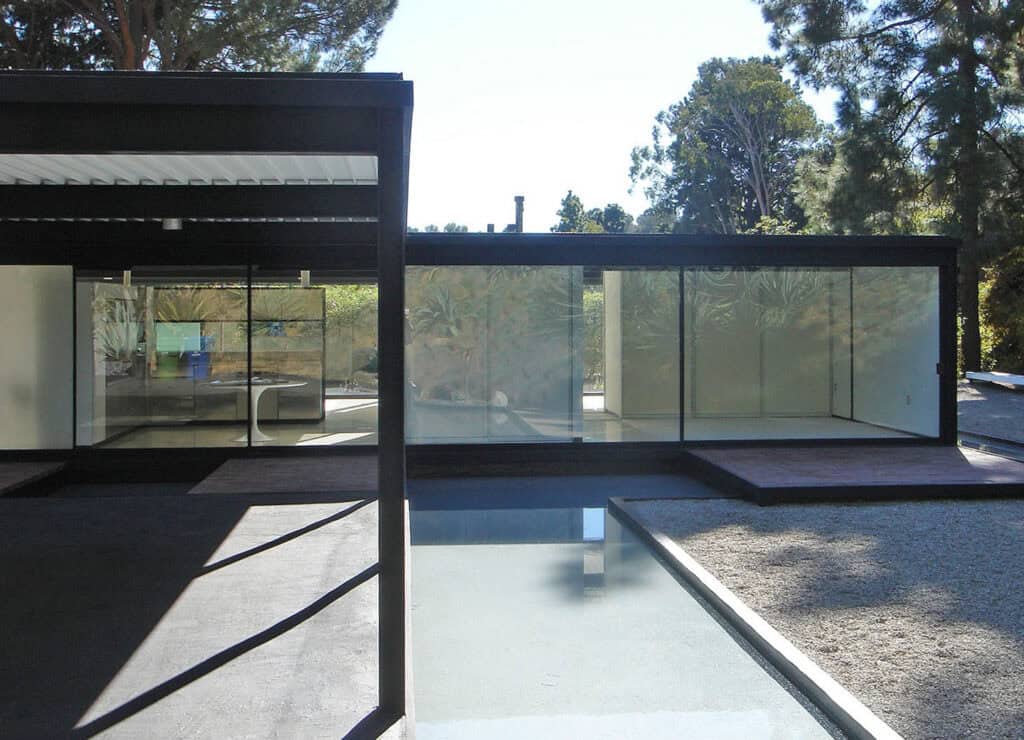
The Bailey House (Case Study House #21) in Los Angeles, designed by Richard Neutra, is a prime example of Mid-Century architecture. Its design features expansive glass walls and integrates beautifully with its natural surroundings, reflecting the style’s focus on light and openness.
See Also What Are the Elements of Modernist Architecture? Discover the 8 Fundamental Features
10. Googie Architecture
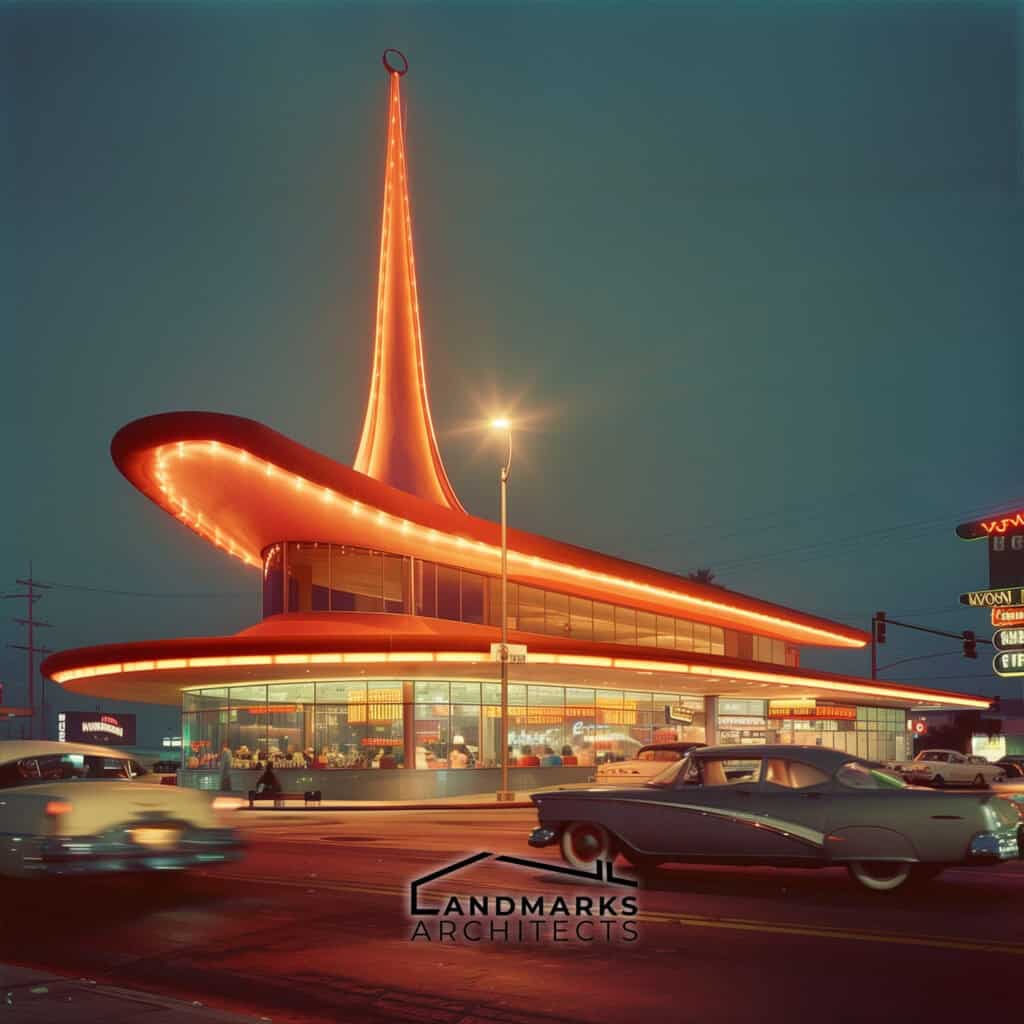
The Googie architectural style emerged in the 1950s and 1960s. It captured the excitement of the space age and the rise of car culture. Googie architecture aimed to attract drivers. It reflected the post-war era’s futuristic spirit, symbolizing modernity and innovation.
Characteristics:
- Sharp, exaggerated angles
- Cantilevered roofs and starburst designs
- Bright neon signage and futuristic elements.
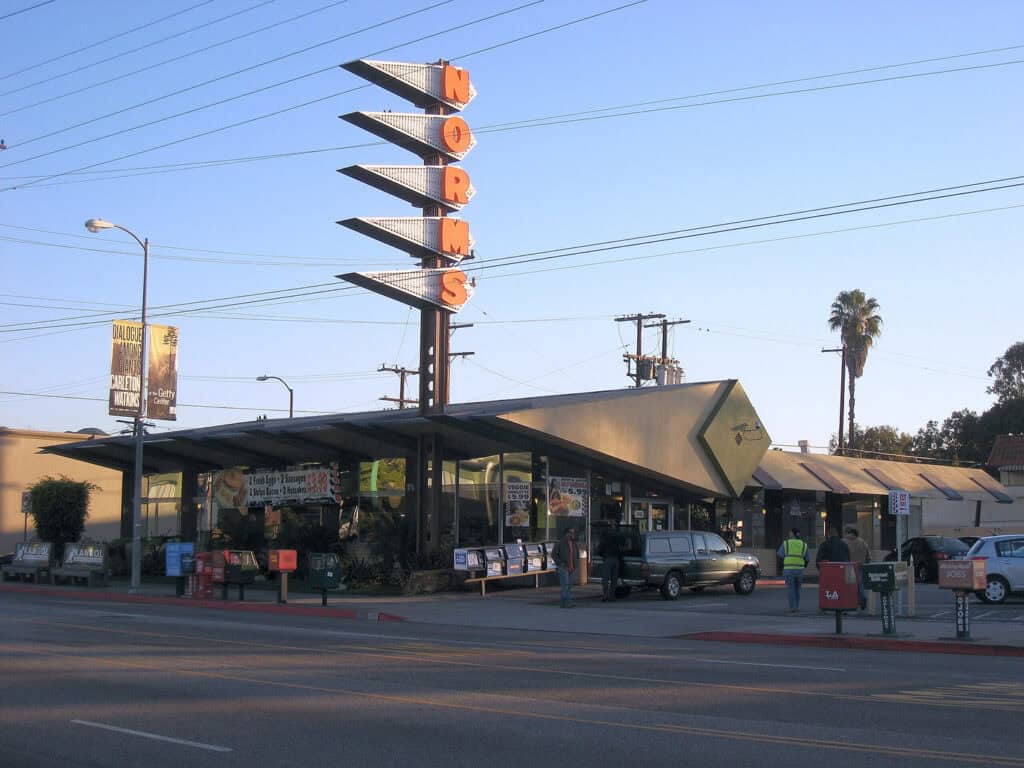
Norms Diner, located on La Cienega Boulevard, stands as a quintessential example of Googie architecture. Its distinctive roof design and bold, futuristic style reflect the era’s enthusiasm for innovation and modernity.
11. International Style
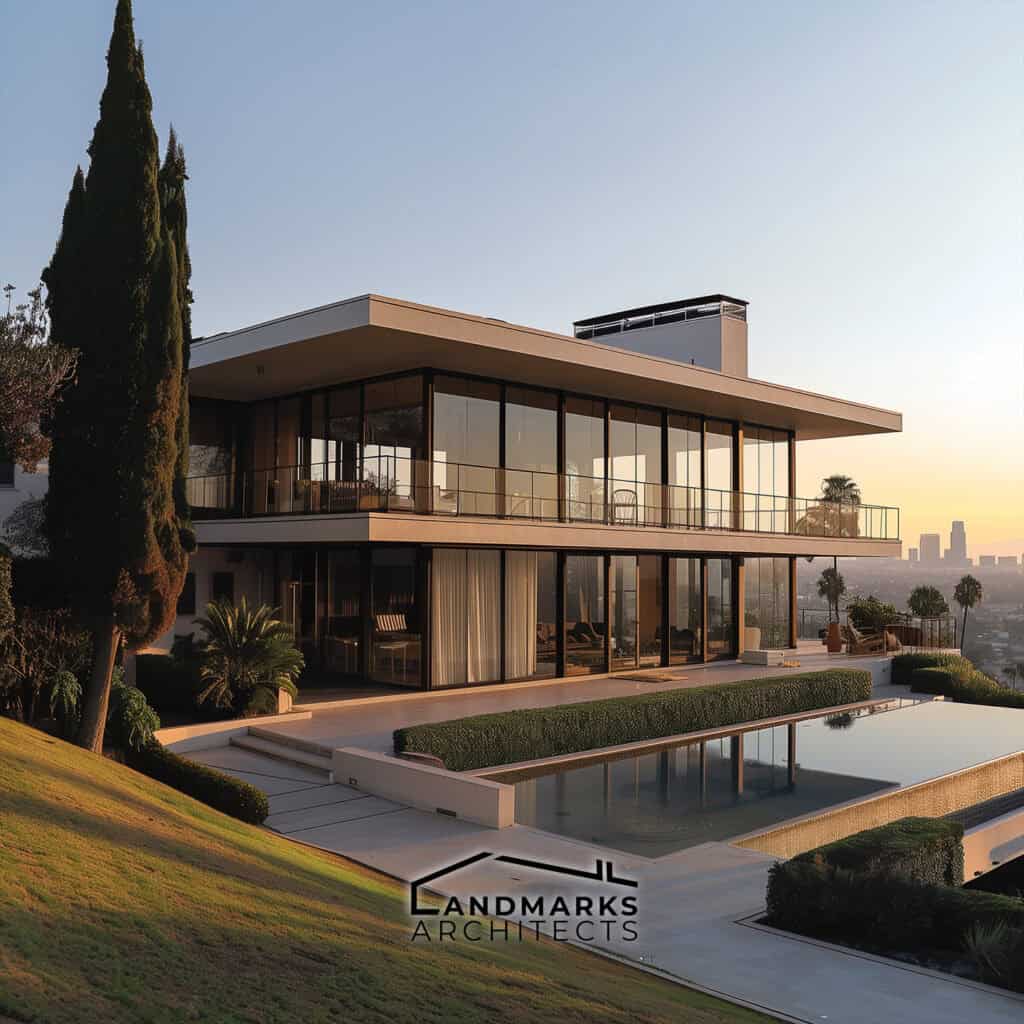
The International Style influenced Los Angeles architecture in the 1920s and 1930s. It emphasized functionalism and minimalism.
Characteristics:
- Flat roofs, smooth surfaces, large glass windows, and functional designs.
- Absence of ornamentation
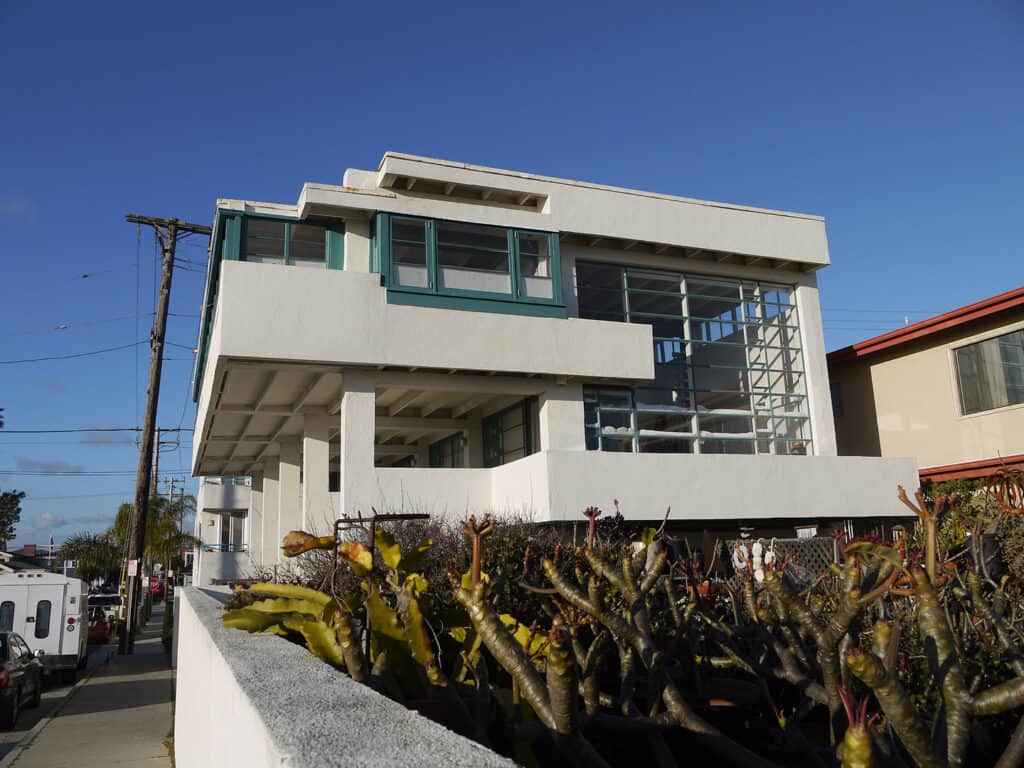
The Lovell House in the Hollywood Hills is a prime example of the International Style. Its sleek, minimalist design and flat roof reflect the style’s focus on function. The expansive glass windows showcase the era’s commitment to modern design principles.
12. Modernist Styles
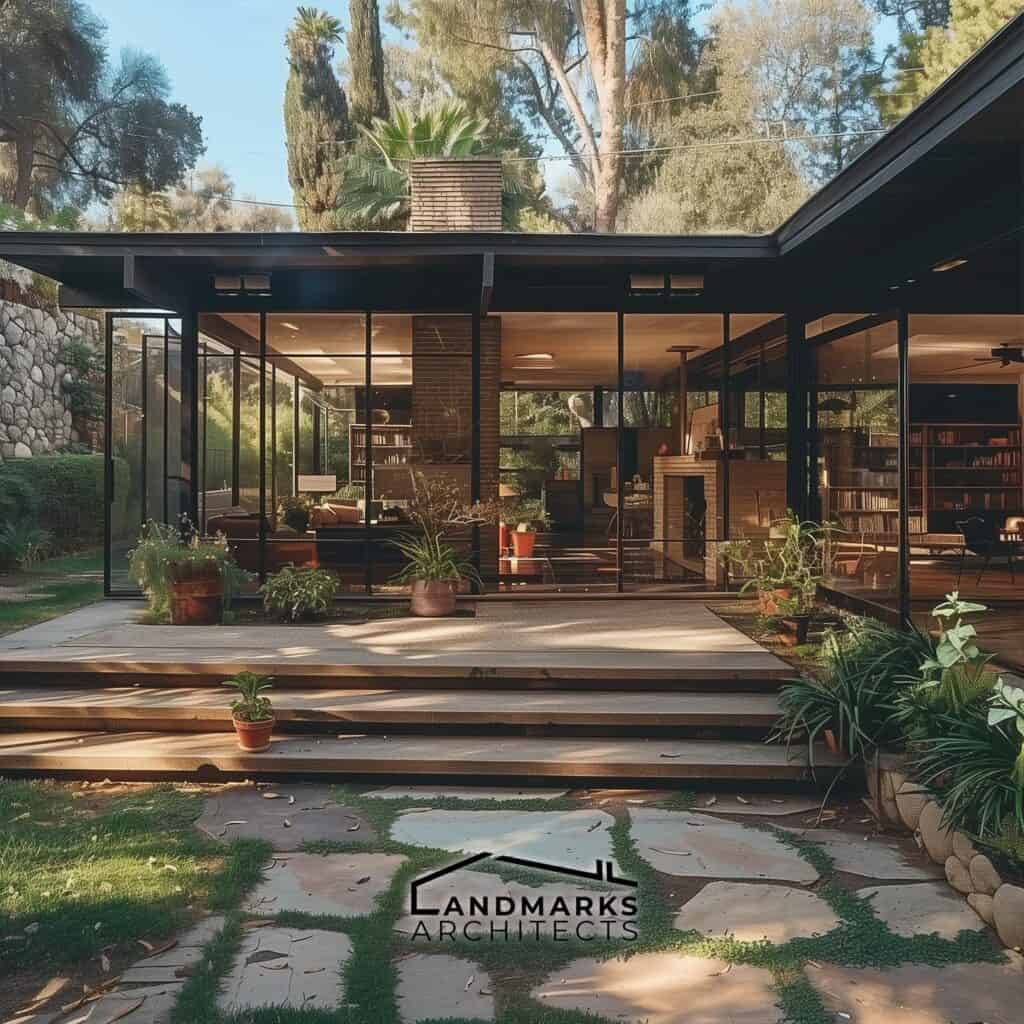
Emerging in the mid-20th century, Modern Architectural Styles in Los Angeles marked a shift from ornate historical designs. They welcomed new materials and techniques.
Modern architecture, influenced by Frank Lloyd Wright, had clean lines and focused on function.
Characteristics:
- Geometric Forms: Focus on simple geometric shapes and clean lines.
- Open Floor Plans: Designs that enhance spatial flow and functionality.
- Use of Industrial Materials: Incorporation of materials such as steel, concrete, and glass.
- Emphasis on Function: Functional design that aligns with the principle that form follows function.
- Integration with Nature: Large windows and designs connect indoor and outdoor spaces.
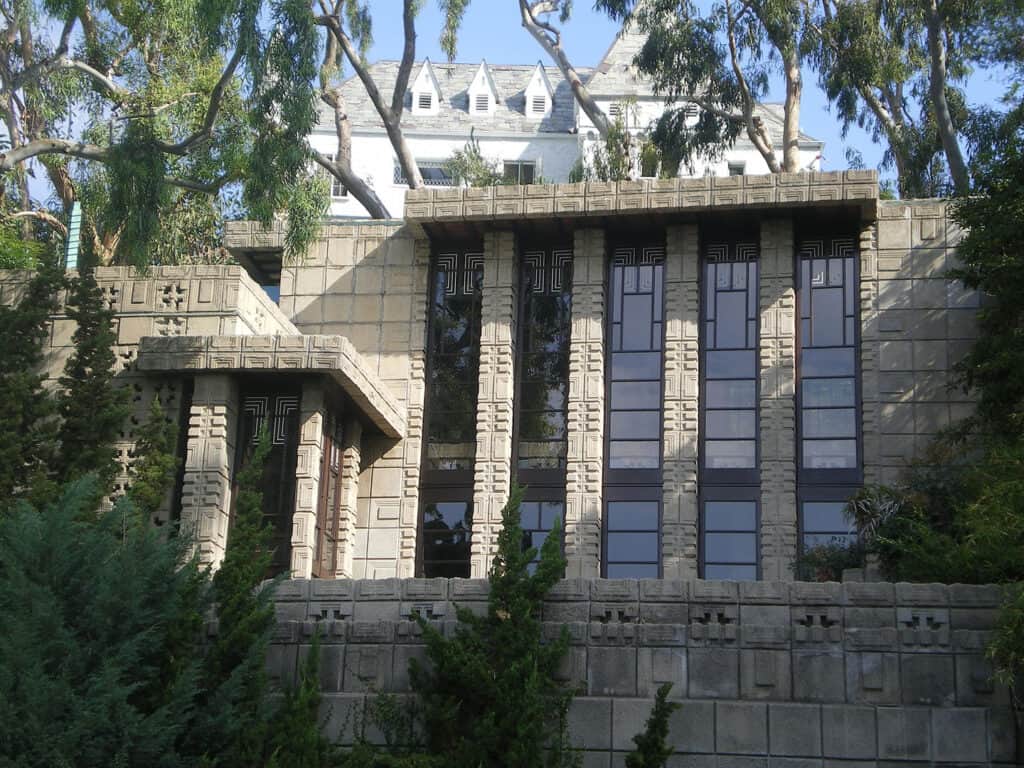
The Storer House, designed by Frank Lloyd Wright, exemplifies Modernist architecture. It has a geometric design, open spaces, and a smooth integration with the landscape.
See Also What Are the Elements of Organic Architecture? 8 Key Elements
Los Angeles Architectural Styles: A Recap
Los Angeles features many architectural styles that define its unique look. From the detailed Victorian and Beaux-Arts to the clean lines of Mid-Century Modern, these styles show how the city has changed over time.
Spanish Colonial Revival and Craftsman Style bring historical charm, while Mid-Century Modern and Googie reflect post-war innovation. Knowing these styles helps you understand the Los Angeles area better and can inspire your design projects.










